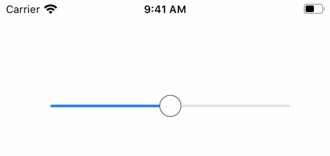Customize UISlider Height - Programmatically Created
You'll need to create a custom slider, and override trackRect(forBounds bounds: CGRect) -> CGRect
class CustomSlider: UISlider {
let trackHeight: CGFloat = 12 //desired track width, in points
override func trackRect(forBounds bounds: CGRect) -> CGRect {
let track = super.trackRect(forBounds: bounds)
return CGRect(x: track.origin.x, y: track.origin.y, width: track.width, height: trackHeight)
}
}
and change your implementation to use this
let slider: CustomSlider = {
let slider = CustomSlider()
slider.minimumValue = 1
slider.maximumValue = 7
slider.value = 1
slider.maximumTrackTintColor = UIColor.red
slider.minimumTrackTintColor = UIColor.green
slider.thumbTintColor = UIColor.blue
slider.isContinuous = true
slider.translatesAutoresizingMaskIntoConstraints = false
return slider
}()
Make UISlider height larger?
I found what I was looking for. The following method just needs to be edited in a subclass.
override func trackRect(forBounds bounds: CGRect) -> CGRect {
var customBounds = super.trackRect(forBounds: bounds)
customBounds.size.height = ...
return customBounds
}
UISlider track not increasing in thickness
As mentioned in many other answers, you can change the height by creating a custom slider as below,
class CustomSlider: UISlider {
override func trackRect(forBounds bounds: CGRect) -> CGRect {
var rect = super.trackRect(forBounds: bounds)
rect.size.height = 7
return rect
}
}
But in your particular case, you are not seeing the change because your implementation is not allowing the factionSlider to use overridden trackRect. To use that you need to change that to CustomSlider as below,
class FactionButton: UISlider {
var factionSlider = CustomSlider()
func factionBalanceSlider(){
factionSlider.frame = CGRect(x: 15, y: 542, width: 386, height: 57)
factionSlider.minimumValueImage = #imageLiteral(resourceName: "Alliance Slider")
factionSlider.maximumValueImage = #imageLiteral(resourceName: "Horde Slider")
factionSlider.setThumbImage(#imageLiteral(resourceName: "Thumb Image"), for: .normal)
factionSlider.minimumTrackTintColor = UIColor(red:0.08, green:0.33, blue:0.69, alpha:0.8)
factionSlider.maximumTrackTintColor = UIColor(red:1.00, green:0.00, blue:0.00, alpha:0.59)
factionSlider.setValue(0.5, animated: true)
factionSlider.isContinuous = true
factionSlider.addTarget(self, action: #selector(recordFactionBalance(sender:)) , for: .valueChanged)
}
func getSlider() -> UISlider {
return factionSlider
}
}
Note In Swift, class name should start with Capital as i updated above. Secondly, I think FactionButton should not be a subclass of UISlider.
UISlider track height
found this but its not working
Because you're using it wrong. You don't call it. You subclass, and override it.
However, the right approach is to supply new images for the track, with setMinimumTrackImage and setMaximumTrackImage.
How to change the size of a UISlider thumb when seeking
Create a normal and larger thumb image with the sizes you want as PDF and add it to the .xcassets.
Then use the following lines of code:
let normal = UIImage(named: "thumbSmall")
slider.setThumbImage(normal, for: .normal)
let highlighted = UIImage(named: "thumbLarger")
slider.setThumbImage(highlighted, for: .highlighted)
Then during sliding the larger thumb image is shown.
A short test looks like this:

Related Topics
iOS Simulator Is Not Launching
Admob Sdk - iOS -File Not Found
Itunes Connect: Can't See Build
iOS How to Dismiss Uialertview with One Tap Anywhere
How to Save Tableview Cell's Checkmark After Reload View Use Nsuserdefaults
Multiple Uicollectionview in One Controller
How to Make Alamofire Download Progress Run in Background iOS
Make Navigationbar's Titleview Larger Than Itself
Programmatically Access Image Assets
Nsstrikethroughstyleattributename , How to Strike Out the String in iOS 10.3
Iso8601Dateformatter Doesn't Parse Iso Date String
Disable iOS Simulator 'Connect Hardware Keyboard' Programmatically
Uitapgesturerecognizer on Uiimageview Within Uitablevlewcell Not Getting Called
Wkwebview and Uimenucontroller
How to Implement Tableview Inside Tableview Cell in Swift 3
iOS Nsnotificationcenter to Check Whether the App Came from Background to Foreground
Simplest Algorithm of Measuring How Similar of Two Short Audio